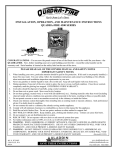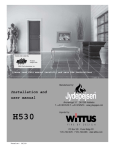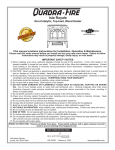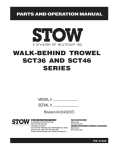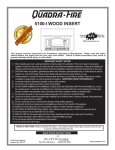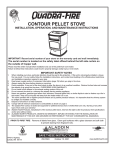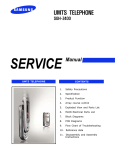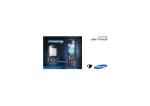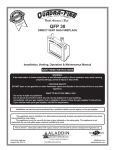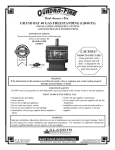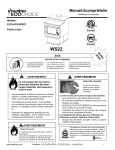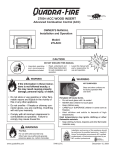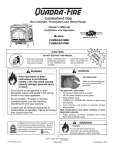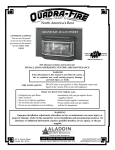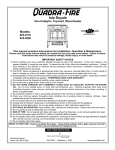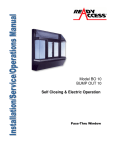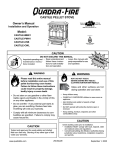Download Quadra-Fire 32198A Stove User Manual
Transcript
R Cape Cod Woodstove Tested and Listed by O-T L Beaverton Oregon USA C CAUTION! The baffle and kaowool blanket placement is crucial to the optimum performance of the stove. Follow the steps on pg. 33 carefully to ensure proper placement of baffles and kaowool at time of initial installation and following chimney cleaning. OMNI-Test Laboratories, Inc. This manual contains instructions for Installation, Operation & Maintenance Please read this entire manual before you install and use your new room heater. Failure to follow instructions may result in property damage, bodily injury, or even death. IMPORTANT SAFETY NOTES: 1) When installing your stove, particular attention should be paid to fire protection. If this room heater is not properly installed, a house fire may result. To reduce the risk of fire, follow the installation instructions. Contact local building or fire officials about restrictions and installation inspection requirements in your area. 2) Never use gasoline or gasoline-type lantern fuel, kerosene, charcoal lighter fluid, or similar liquids to start or “freshen up” a fire in this heater. Keep all such liquids well away from heater while it is in use. 3) During operation, if any part of the stove starts to glow, the stove is in an overfired condition. Close the air controls completely until the glowing has stopped. OVERFIRING VOIDS YOUR WARRANTY! 4) Cool ashes should be disposed of carefully, using a metal container. 5) Do not burn wet or green wood. Store wood in a dry location. 6) DO NOT BURN GARBAGE OR FLAMMABLE FLUIDS SUCH AS GASOLINE, NAPHTHA OR ENGINE OIL. Do not burn treated wood, or wood with salt (driftwood, etc.). Burning materials other than wood (including charcoal) under adverse conditions may generate carbon monoxide in the home, resulting in illness or possible death. 7) Do not permit creosote or soot to accumulate excessively in the chimney or inside the firebox. 8) Check your chimney system thoroughly when installing into an existing metal or masonry chimney. Seek professional advice if in doubt about its condition. 9) Do not connect this unit to a chimney flue already serving another appliance. 10) Comply with all minimum clearances to combustibles as shown in this manual for this appliance. 11) Build fire on brick firebox floor. Do not use grates, andirons or other methods to support fuel. 12) HOT WHILE IN OPERATION! Keep children, pets, clothing and furniture away. Contact can cause skin burns. 13) Do not connect to any air distribution duct or system 14) RISK OF FIRE! Do not operate with stove door or ash removal system door open. 15) For further information refer to NFPA 211 (US) or CAN/CSA-B365 (Canada). 16) Do not operate without fully assembling all components. Burning your stove without the legs attached (if supplied with unit) will void your warranty, and could present a serious safety hazard. A Division of Hearth Technologies Inc. 1445 N. Highway Colville, WA 99114 SAVE THESE INSTRUCTIONS Part No. 32198A February 15, 2002 www.aladdinhearth.com R Cape Cod Wood Stove NOTES My new Cape Cod wood stove.... SERIAL NUMBER: DATE PURCHASED: DEALERSHIP: DEALER PHONE #: ADDITIONAL INFORMATION PERTINENT TO YOUR INSTALLATION: ATTACH SALES RECEIPT & WARRANTY STUB HERE: Page 2 This information will be necessary should your stove require Warranty service. 32198A February 15, 2002 R Cape Cod Wood Stove WELCOME Aladdin Hearth Products welcomes you to our tradition of excellence! In choosing a Quadra-Fire appliance, you have our assurance of commitment to quality, durability, and performance. This commitment begins with our research of the market, including ‘Voice of the Customer’ contacts, ensuring we make products that will satisfy your needs. Our Research and Development facility then employs the world’s most advanced technology to achieve the optimum operation of our stoves, inserts and fireplaces. And yet we are old-fashioned when it comes to craftsmanship. During manufacturing each unit is meticulously fabricated and gold surfaces are hand-finished for lasting beauty and enjoyment. Our pledge to quality is completed as each model undergoes a quality control inspection. Additionally, we feel it is important to offer you several finishing options and accessories to compliment your home’s décor, individualize the use of your appliance, and provide financial options in acquiring a quality hearth appliance. Ask your Quadra-Fire Dealer for information on these options. From design, to fabrication, to shipping: Our guarantee of quality is more than a word, it’s Quadra-Fire tradition, and we proudly back this tradition with a Lifetime Warranty. Prior to installation, we ask you to take a few moments to read this manual. It has been our experience that your overall enjoyment of your new appliance will be greatly enhanced by becoming familiar with its’ installation, operation and maintenance requirements. We wish you and your family many years of enjoyment in the warmth and comfort of your hearth appliance. Thank you for choosing Quadra-Fire. With warm regards, ______________________ Group Vice President ______________________ Vice President Research & Development _____________________ Vice President Marketing & Product Planning _______________________ Controller ______________________ General Manager ______________________ Quality / Technical Support Manager _______________________ Manufacturing Engineer Manager _______________________ Central Sales Manager ______________________ Eastern Sales Manager _______________________ Order Fulfillment Manager _______________________ Sr. Purchasing Agent ______________________ Human Resources & Community Relations 32198A February 15, 2002 Page 3 R Cape Cod Wood Stove TABLE OF CONTENTS LISTINGS............................................................5 SERIAL LABEL & LOCATON ..........................6 DIMENSIONS.....................................................7 CLEARANCES TOP VENT INSTALLATIONS .....................8 REAR VENT INSTALLATIONS..................9 FLOOR PROTECTION.................................10 ACCESSORIES ...................................................11 INSTALLATION CHIMNEY HEIGHT REQUIREMENTS .....12 FLUE SYSTEMS ..........................................13 CHIMNEY CONNECTOR ...........................13 MASONRY CHIMNEY ................................14 8" SOLID PACK CHIMNEY WITH METAL SUPPORTS AS A THIMBLE ......15 TO A MASONRY FIREPLACE....................16 TO A METAL PREFAB CHIMNEY.............19 TO AN INTERIOR METAL PREFAB CHIMNEY ..................................20 TO AN EXTERIOR METAL PREFAB CHIMNEY ..................................21 MOBILE HOME INSTALLATION ..............22 ASSEMBLY...................................................23 REVERSIBLE FLUE COLLAR ...................23 FIREBRICK PLACEMENT..........................23 OUTSIDE AIR KIT INSTALLATION..........24 BLOWER ......................................................25 Page 4 OPERATION PRE-USE CHECK.........................................26 BURNING PROCESS ...................................26 WOOD SELECTION AND STORAGE........27 AIR CONTROLS..........................................28 OPERATING TIPS ........................................29 HEAT OUTPUT SETTING...........................29 BUILDING A FIRE.......................................30 BREAK-IN PERIOD .....................................30 ASH REMOVAL ..........................................31 MAINTENANCE ................................................31 CREOSOTE-FORMATION & REMOVAL ..32 CHIMNEY CLEANING ...............................32 GLASS CARE & REPLACEMENT .............34 DOOR & GASKET ......................................35 KAOWOOL BAFFLE BLANKET................35 TROUBLE-SHOOTING DRAFT PROBLEMS ....................................36 FLUE DRAFT ...............................................37 PARTS..................................................................38 WARRANTY.......................................................39 32198A February 15, 2002 R Cape Cod Wood Stove LISTINGS & CODE APROVALS LISTINGS These installation instructions describe the installation and operation of the Cape Cod woodstove. This stove meets the U.S. Environmental Protection Agency’s 1990 particulate emission standards. cannot be unexpectedly cancelled. If any assistance is required during installation, please contact your local dealer. The Cape Cod is listed by OMNI-Test Laboratories, Inc. to UL Safety Standard 1482, UL 737, and ULC S627 and (UM)84-HUD. Inspect and clean vent system frequently in accordance with the instructions contained in this manual. Do not connect this unit to a chimney serving another appliance. The Cape Cod is approved for mobile home installations when not installed in a sleeping room and when an outside combustion air inlet is provided. The structural integrity of the mobile home floor, ceiling and walls must be maintained. The stove must be properly grounded to the frame of the mobile home. Outside Air Kit, part #831-1780 must be installed in a mobile home installation. Check with your local building code agency before you begin your installation to ensure compliance with local codes, including the need for permits and follow-up inspections. Be sure local building codes do not supersede UL specifications and always obtain a building permit so that insurance protection benefits WARNING ! DO NOT ATTEMPT TO OPERATE THIS WOODSTOVE WITHOUT READING AND UNDERSTANDING THESE OPERATING INSTRUCTIONS THOROUGHLY. FAILURE TO OPERATE THIS APPLIANCE PROPERLY MAY CAUSE A SERIOUS HOUSE FIRE. WARNING ! THE OUTSIDE SURFACES OF THIS UNIT WILL BECOME EXTREMELY HOT DURING USE. ALWAYS KEEP CHILDREN AWAY WHILE IT IS OPERATING AND DO NOT LET ANYONE OPERATE THIS APPLIANCE UNLESS THEY ARE FAMILIAR WITH THESE OPERATION INSTRUCTIONS. 32198A February 15, 2002 When using optional Blower, part #831-1700, route power cord away from unit. Do not route cord under or in front of appliance. Do not use grate or elevate fire. Build wood fire directly on firebrick. Do not overfire - if heater or chimney connector glows, you are overfiring. Operate only with the feed doors closed. Open only to add fuel to the fire. Operating with the door open can cause hot embers or sparks to fall out and a fire may result. Optional Fire Screen, part #834-3610, may be used ONLY in U.S. residential installations with a 6" continuous vertical flue to termination. WARNING! NEVER DRAW COMBUSTION AIR FROM A WALL, FLOOR OR CEILING CAVITY OR FROM ANY ENCLOSED SPACE SUCH AS AN ATTIC OR GARAGE. BURNING YOUR STOVE WITHOUT THE LEGS ATTACHED WILL VOID YOUR WARRANTY AND COULD PRESENT A SERIOUS SAFETY HAZARD. Page 5 Page 6 C O-T L Beaverton Oregon USA OMNI-Test Laboratories, Tested and Listed by TESTED TO: UL 1482, UL 737, ULC S627. Report #061-S-15-2 R VENT SPECIFICATIONS: Cape Cod SERIAL NO. Manufactured by: 36-3/4 16" from glass 8" 2-3/16 USA 5-13/16 Fuel loading door 5-13/16 A Division of Hearth Technologies Inc. 2-3/16 39-1/4 1445 N. Highway, Colville, WA 99114 *If Hearth Leg kit is used in rear vent installation, Floor Protector must extend 18" in front of the feed door opening. 203mm (8") 1251mm (49-1/4") N/A 27.5 (698) 18 (457) N/A N/A N/A 41/15** (1041/381) 12/6* (305/152) Jan. A C D E Feb. Mar. Apr. May June July Aug. Sept. Oct. Nov. B F F E 8" Max G G I ** U.S. ENVIRONMENTAL PROTECTION AGENCY Certified to comply with July 1990 particulate emission standards. 32710A *(I) with 52" high x 42" wide wall protection spaced 1" (25mm) from combustible surface. SEE NOTE A above. **(G) with shield spaced 1" (25mm) away from bottom mantel surface N/A DO NOT REMOVE THIS LABEL Made in U.S.A. 2003 2004 CANADA 203mm (8") 2002 1080mm (32-1/2") 457mm (18") 203mm (8") indicated on the diagram below. Exception: Non-combustible floor protections must extend beneath the flue pipe when installed with horizontal venting and extend 2" (51mm) beyond each side. NOTE: Floor protector #842-3950 is required for use in Canada in addition to hearth protection. FOR REAR VENT INSTALLATIONS: IN A MASONRY FIREPLACE OR THROUGH THE WALL: Six inch (6") (152mm) diameter listed double wall air insulated connector pipe with UL 103 HT listed factory-built Class "A" chimney, or a masonry chimney. (Mobile Home FLOOR PROTECTION: must be equipped with a spark arrestor). Additional specifications include a maximum 8" deep mantel without heat shield Floor protector must be a 1" min. thickness (k value = .45), non-combustible and the following clearances. material or equivalent, extending beneath heater and to front/sides/rear as I H G F E D C B A SAFETY LABEL only to add fuel to the fire. Optional Fire Screen Part 834-3610, may be used ONLY in U.S. residential installations. Install and use only in accordance with manufacturer's installation SINGLE WALL: Six inch (6") (152mm) diameter, minimum 24 MSG black or blued steel connector pipe, with a listed and operating instructions. Contact local building or fire officials factory-built UL103 HT Class "A" chimney, suitable for use with solid fuels, or a masonry chimney, and the about restrictions and installation inspections in your area. Do not referenced clearances. obstruct the space beneath heater. WARNING - For Mobile Homes: Do not install in a sleeping room. DOUBLE WALL: Six inch (6") (152mm) diameter, listed double wall air insulated connector pipe with listed factoryAn outside combustion air inlet must be provided and unrestricted built 103 HT Class "A" chimney, or a masonry chimney and the referenced clearances. while unit is in use. The structural integrity of the mobile home floor, ceiling and walls must be maintained. The stove needs to be MOBILE HOME: Use double wall pipe by Dura-Vent DVL, Selkirk Metalbestos DS or Security DL double wall properly grounded to the frame of the mobile home. Components connector pipe. Must be equipped with a spark arrestor. Apply double wall clearances below when installing unit. required for mobile home installation: Outside Air Kit, Part Number MINIMUM CLEARANCES TO COMBUSTIBLE MATERIALS: In Inches & (Millimeters) 831-1780. Refer to manufacturer's instructions and local codes for precautions NOTE: All "A" , "C" and "F" Dimensions are to the inside diameter of the flue collar. required for passing chimney through a combustible wall or ceiling FOR TOP VENT INSTALLATIONS: and maximum offsets. I H G F E D C B A Inspect and clean chimney frequently - Under Certain Conditions of 16 (406) 16 (406) 31.5 (800) 22 (558) 16 (406) 21(533) 55 (1397) 18 (457) 16 (406) SINGLE WALL PIPE H Use, Creosote Buildup May Occur Rapidly. Do not connect this unit to a chimney serving another appliance. 12 (305) 12(305) 27.5 (698) 18 (457) 12 (305) 17 (431) 55 (1397) 18 (457) 12 (305) DOUBLE WALL PIPE Optional Components: Optional Blower, Part 831-1700. G 6 (152)* Electrical Rating: 115 VAC, 1.2 Amps, 60 Hz. INSTALLATION: ALCOVE - Six inch (6") (152mm) diameter listed DOUBLE WALL air insulated connector pipe with UL Route power cord away from unit. Do not route cord over or in front 103 HT listed factory-built Class "A" chimney, or a masonry chimney. (Mobile Home must be equipped with a spark of appliance. arrestor.) Maximum depth of Alcove shall be no more than 38"(965mm) with a minimum height of 55" (1397mm) to top of DANGER: Risk of electrical shock. Disconnect power supply unit, and the referenced clearances. before servicing. I Replace glass only with 5mm ceramic available from your dealer. NOTE A: A wall protector must be a minimum of 24 gauge sheet metal with a 1" (25mm) air space between sheet metal Do not use grate or elevate fire. Build wood fire directly on hearth. and combustible wall. Sheet metal may then be covered with brick or tile. Do not overfire - if heater or chimney connector glows, you I H G F E D C B A are overfiring.Operate only with the feed door closed. Open DOUBLE WALL PIPE 55 (1397) 18 (457) 14 (356) N/A N/A 14 (356) 27.5 (698) 18 (457) 14 (355) PREVENT HOUSE FIRES LISTED ROOM HEATER, SOLID FUEL TYPE. ALSO FOR USE IN MOBILE HOMES. (UM) 8464HUD . "For Use with Solid Wood Fuel Only" CAUTION: HOT WHILE IN OPERATION DO NOT TOUCH, KEEP CHILDREN AND CLOTHING AWAY. CONTACT MAY CAUSE SKIN BURNS. KEEP FURNISHINGS AND OTHER COMBUSTIBLE MATERIAL FAR AWAY FROM THE APPLIANCE. SEE NAMEPLATE AND INSTRUCTIONS R Cape Cod Wood Stove LABEL LOCATION: BACK OF STOVE 32198A February 15, 2002 R Cape Cod Wood Stove DIMENSIONS FRONT VIEW 27" 26-1/2 29" SIDE VIEW 8-1/4" 27-1/2" 22-1/2" 16-1/4" 29-3/4" 16" 24-1/4" 32198A February 15, 2002 Page 7 R Cape Cod Wood Stove CLEARANCES TOP VENT INSTALLATIONS MINIMUM CLEARANCES TO COMBUSTIBLES (In inches and millimeters.) FIGURES 1, 2 & 3 SINGLE WALL: Six inch (6") diameter single wall, minimum 24 MSG black or blued steel connector pipe, with a listed factory-built chimney suitable for use with solid fuels, or a masonry chimney, and the following clearances: A 16"(406) B 16"(406) C 31.5"(800) D 22"(558) E 16"(406) F 21"(533) G 55"(1397) H 18"(457) I 16"(406) DOUBLE WALL & MOBILE. HOME: Six inch (6") diameter double wall air insulated connector pipe with listed factorybuilt Class “A” chimney, or a masonry chimney, (Mobile Home must be equipped with a spark arrestor), and the following clearances: Use double wall pipe by Dura-Vent DVL, Selkirk Metalbestos DS or Security DL double wall connector pipe. (Mobel Home must equipped with a spark arrestor), and teh following clearances: A 12"(305) B 12"(305) C 27.5"(698) D 18"(457) E 12"(305) F 17"(431) G 55"(1397) H 18"(457) I 12”(305) /6"*(152) IN AN ALCOVE: Six (6") inch diameter double wall air insulated connector pipe with listed factory-built Class “A” chimney, or a masonry chimney. (Mobile Home must be equipped with a spark arrestor.) Additionally, maximum depth of alcove shall be no more than 38"(965mm), and a minimum of 55"(1397mm) high above stove top to a combustible. The following clearances apply: A 14"(355) B 14"(355) C 27.5"(698) D 18"(457) E N/A F N/A G 55"(1397) H 18"(457) I 14"(355) *With 52" high x 42" wide wall protection spaced 1" from combustible surface. . WALL PROTECTOR SPECIFICATIONS: MUST BE A MINIMUM OF 24 GAUGE SHEET METAL WITH A 1" (25MM) AIR SPACE BETWEEN SHEET METAL AND COMBUSTIBLE WALL. SHEET METAL MAY THEN BE COVERED WITH BRICK OR TILE. H G A B E C F F D FIGURE 1 Page 8 I E FIGURE 2 FIGURE 3 32198A February 15, 2002 R Cape Cod Wood Stove REAR VENT INSTALLATIONS CLEARANCES MINIMUM CLEARANCES TO COMBUSTIBLES (In inches and millimeters) FIGURE 4 In a Masonry Fireplace OR Through the Wall: Six inch (6") diameter listed double wall air insulated connector pipe with listed factory-built Class “A” chimney or a masonry chimney. (Mobile Home must be equipped with a spark arrestor.) Additional specifications include a maximum 8" deep mantel without heat shield and the following clearances: A N/A B N/A C 27.5"(698) D 18"(457) E N/A G G H N/A I 12" (305), 6"*(152) **Maximum 8" deep mantel with heatshield spaced 1" from bottom mantel surface. CL FIGURE 4 G 41"(1041) / 15"**(381) *With 52" high x 42" wide wall protection spaced 1" from combustible surface.. WALL PROTECTOR SPECIFICATIONS: MUST BE A MINIMUM OF 24 GAUGE SHEET METAL WITH A 1" (25MM) AIR SPACE BETWEEN SHEET METAL AND COMBUSTIBLE WALL. SHEET METAL MAY THEN BE COVERED WITH BRICK OR TILE. Max 8" I F N/A 26-5/8" CAUTION! The baffle and kaowool blanket placement is crucial to the optimum performance of the Cape Cod. Follow the steps on pages 32 & 33 (Chimney Cleaning), carefully to ensure proper placement of baffles and kaowool at time of initial installation and following chimney cleaning. If further clearances are needed, obtain requirements for construction of a protected wall from your local building code authorities and their allowable reductions of the listed clearances. 32198A February 15, 2002 Page 9 R Cape Cod Wood Stove CLEARANCES NOTE: Additional floor protection is required on rear vent installations. For this type of installation the floor protector must extend the length of the flue and 2" to each side of the flue. Floor protection can consist of a U.L. Listed floor protector, or the site fabricated hearth protector described below. FIGURE 5A 2-3/16 5-13/16 The floor must be non-combustible or otherwise adequately protected from radiant heat given off by the unit and from sparks and falling embers. A layer of thin brick or ceramic tile over a combustible floor is not sufficient. In US installations, it is necessary to install a floor protector of 1" (k value = .45) thick metal clad millboard or equivalent at least 16" in front and 8" to both sides of the loading door. See Figures 5A & 5C. In Canada, similar floor protection must be provided 18" in front and 8" from the sides and rear of the stove. See Figures 5B & 5C. 39-1/4 Fuel loading door 16" from glass FLOOR PROTECTION FIGURE 5C 8" Non-combustible decorative covering or .018 min. sheet metal. USA 36-3/4 USA MINIMUM FLOOR PROTECTOR: 36-3/4" WIDE x 39-1/4" DEEP If Hearth Leg kit is used in rear vent installation, Floor Protector must extend 18” in front of the fuel loading door. Insulation min. R value 2.2 Required Thickness “k” Value MICORE 300 1" .45 FIGURE 5B 203mm (8") (Thermal Conductivity) “k” = BTU in./hr. ft2 F (based on 1" thickness) 203mm (8") 203mm (8") 1251mm (49-1/4") To substitute alternate insulation material, you need to know the “k” factor for that material. To calculate the required thickness for the alternate material use the following formula: 457mm (18") “k” CANADA .45 1080mm (32-1/2") CANADIAN MINIMUM FLOOR PROTECTOR: 32-1/2" WIDE x 49-1/4” DEEP ADDITIONAL FLOOR PROTECTOR REQUIREMENT: Part #842-3950, provided with stove, must be placed beneath ash catcher extending lengthwise towards front of stove. Page 10 of Alternate material x .50 = Thickness of alternatematerial (inches) EXAMPLE: The “k” value of brick = 5 5 .45 x .50 = 5.5 inches of brick is required to meet the requirement. 32198A February 15, 2002 R Cape Cod Wood Stove ACCESSORIES The Cape Cod has several options available for installation and appearance. These options are packaged and sold separately and are listed below. It is a good idea to plan your installation on paper, using exact measurements for clearances and floor protection, before actually beginning the installation. If you’re not using an existing chimney, place the stove where there will be a clear passage for a factory-built listed chimney through the ceiling and roof. AVOID FIRE: Maintain the designated clearances to combustibles. Insulation must not touch the chimney. You must maintain the designated air space clearance around the chimney. This space around a chimney is necessary to allow natural heat removal from the area. Insulation in this space will cause a heat buildup, which may ignite wood framing. NOTE: Clearances may only be reduced by means approved by the regulatory authority having jurisdiction. We also recommend that you have a qualified building inspector and your insurance company representative review your plans before installation. Part Number 831-1700 831-1780 844-7980 844-7970 834-3610 834-3531 834-3551 834-3561 834-4110 834-4120 842-3950 834-3800 834-3820 834-3830 834-4130 834-4140 Description 160 cfm Electric Blower Outside Air Kit Gold Brackets w/mitten rod Black Brackets w/mitten rod Fire Screen (US Installations ONLY) Warming Shelves Matte Black WS3-2 MBK Porcelain Creme , WS3-2 PCR Porcelain Green, WS3-2 PGR Porcelain Majolica, WS3-2 PMJ Porcelain Blue/Black, WS3-2 PBB Canadian Floor Protector *Hearth Legs Matte Black, MBK Porcelain Creme, PCR Porcelain Green, PGR Porcelain Majolica, PMJ Porcelain Black/Blue, PBB *If you install Hearth Legs please note that you can install an Outside Air Kit or Blower but not both. 32198A February 15, 2002 Page 11 R Cape Cod Wood Stove INSTALLATION A masonry chimney or a factory-built chimney must be the required height above the roof and any other nearby obstructions. The chimney must be at least three feet higher than the highest point where it passes through the roof and at least two feet higher than the highest part of the roof or structure that is within ten feet of the chimney, measured horizontally. See Figure 6. These are safety requirements and are not meant to assure proper flue draft. We recommend using a minimum total system height of 12' (365.7 cm), not including the chimney cap, measured from the stove flue collar to the top of the chimney. CHIMNEY HEIGHT REQUIREMENTS FIGURE 6 2-10-3 RULE 3 ft Min (91cm) 2 ft Min (61cm) 10 ft Min (305cm) INSTALLATION MATERIALS NEEDED FOR YOUR SAFETY CHIMNEY CONNECTOR (also known as flue pipe or stove pipe): The chimney connector joins the stove to the chimney (see page 10). It must be 6” (152mm) minimum diameter 24 MSG black or blued steel, or an approved air-insulated double wall venting pipe. THIMBLE: A manufactured or site-constructed device installed in combustible walls through which the chimney connector passes to the chimney (see page 12). It is intended to keep the walls from igniting. CHIMNEY SYSTEMS: A. APPROVED MASONRY (see specifications on page 11) with at least 5/8” (16mm) fire clay lining joined with refractory cement or other listed system suitable for use with wood stoves. B. PREFABRICATED 6" (152mm) listed high temperature (UL 103 HT or ULC S629M) chimney. Components required by manufacturers for installation such as the chimney support base, firestop (as appropriate), attic insulation shield, insulated tee, etc., are necessary to assure a safe chimney installation. Use only components manufactured for the chimney. Chimney installation must meet NFPA 211 standards. FIRE SAFETY: To provide reasonable fire safety, the following should be given serious consideration: 1. 2. 3. 4. Page 12 Install at least one smoke detector on each floor of your home to ensure your safety. They should be located away from the heating appliance and close to the sleeping areas. Follow the smoke detector manufacturer’s placement and installation instructions, and be sure to maintain regularly. A conveniently located Class A fire extinguisher to contend with small fires resulting from burning embers. A practiced evacuation plan, consisting of at least two escape routes. A plan to deal with a chimney fire as follows: In the event of a chimney fire: A. Notify fire department B. Prepare occupants for immediate evacuation. C. Close all openings into the stove. D. While awaiting fire department, watch for ignition of adjacent combustibles from overheated stove pipe, hot embers or sparks from the chimney. 32198A February 15, 2002 R Cape Cod Wood Stove FLUE & VENTING SYSTEMS INSTALLATION WARNING: ALWAYS FOLLOW CHIMNEY CONNECTOR MANUFACTURER’S INSTRUCTIONS FOR PROPER INSTALLATION. CHIMNEY CONNECTOR IS TO BE USED ONLY WITHIN THE ROOM, BETWEEN THE STOVE AND CEILING WALL, NEVER PASSING THROUGH A COMBUSTIBLE CEILING OR WALL. THE CONNECTOR SHALL NOT PASS THROUGH AN ATTIC OR ROOF SPACE, CLOSET OR SIMILAR CONCEALED SPACE, OR A FLOOR, OR CEILING. MAINTAIN MINIMUM CLEARANCES TO COMBUSTIBLES AS REFERENCED ON PAGES 9, 10 & 11. WARNING: IF INSTALLING THIS MODEL TO A MASONRY CHIMNEY, ALWAYS BE SURE THE CHIMNEY IS IN GOOD CONDITION AND THAT IT MEETS THE MINIMUM STANDARDS OF THE NATIONAL FIRE PROTECTION ASSOCIATION (NFPA) STANDARD 211. A FACTORY BUILT CHIMNEY MUST BE 6” UL 103 HT. THIS APPLIANCE IS MADE WITH A 6 INCH/152mm DIAMETER CHIMNEY CONNECTOR AS THE FLUE COLLAR ON THE UNIT. CHANGING THE DIAMETER OF THE CHIMNEY CAN AFFECT DRAFT AND CAUSE POOR PERFORMANCE. IT IS NOT RECOMMENDED TO USE OFFSETS OR ELBOWS AT ALTITUDES ABOVE 4000 FEET ABOVE SEA LEVEL OR WHEN THERE ARE OTHER FACTORS THAT AFFECT FLUE DRAFT. VENTING SYSTEM The venting system consists of a chimney connector and a chimney. These get extremely hot during use. Temperatures inside the chimney may exceed 2000°F (1100°C) in the event of a creosote fire. To protect against the possibility of a house fire, the chimney connector and chimney must be properly installed and maintained. An approved thimble must be used when a connection is made through a combustible wall to a chimney. A chimney support package must be used when a connection is made through the ceiling to a prefabricated chimney. These accessories are absolutely necessary to provide safe clearances to combustible wall and ceiling material. Follow venting manufacturer’s clearances when installing venting system. This stove may be connected to a lined masonry chimney or a listed high temperature prefabricated approved metal chimney. Do not connect it to a chimney serving another appliance. To do so will affect the safe operation of both appliances. There are two separate and different parts to a flue system: the chimney connector and the chimney itself. A. Single wall connector or stovepipe. This must be at least 24 gauge mild steel or 26 gauge blue steel. The sections must be attached to the stove and to each other with the crimped (male) end pointing toward the stove. See Figure 7. All joints, including the connection at the stove collar, should be secured with three sheet metal screws. Make sure to follow the minimum clearances to combustibles as set out on pages 8 and 9 of this manual. Where passage through the wall, or partition of combustible construction is desired, the installation shall conform to CAN/CSA-B365. CHIMNEY CONNECTOR TOWARDS STOVE FLUE GAS DIRECTION B. Factory-built listed chimney connector (vented). A listed connector (vented) must be used when installing this unit in a mobile home. A Listed chimney and Listed connector must be used. It must be the same brand as the listed chimney to ensure a proper fit and seal. FIGURE 7 32198A February 15, 2002 Page 13 R Cape Cod Wood Stove INSTALLATION For optimal performance, masonry chimneys used to vent this appliance should be lined with a 6" stainless steel liner. Installations into a clay flue without a stainless steel liner may reduce efficiency, cause the glass to darken, and produce excessive creosote. Ensure that a masonry chimney meets the minimum standards of the National Fire Protection Association (NFPA) Standard 211. It must have at least a 5/8" (16mm) fire clay liner or a listed chimney liner system. See Figure 8. Make sure there are no cracks, loose mortar or other signs of deterioration and blockage. It is best to have the chimney inspected by a professional and be sure to have the chimney cleaned before the stove is installed and operated. The flue should be checked to determine that it is not too large for the stove. NFPA 211 allows the cross-sectional area of the flue to be no more than 3 times the cross-sectional area of the flue collar of the stove (28 x 3 = 84 square inches). It is recommended that a chimney with a larger diameter be relined, since the oversized flue can cause poor performance and contribute to the accumulation of creosote. (See page 36 for more information about troubleshooting draft problems). MASONRY CHIMNEY Wood Stud 2" (51mm) Clearance from chimney wall Fireclay liner 5/8" (16mm) Minimum or Equivalent. Header Fireclay liner 5/8" (16mm) Minimum or Equivalent. Sill support Thimble Assembly: 12" (305mm) of brick separation between clay liner and combustibles. NOTE; Never install more than one appliance to any chimney. When connecting the stove through a combustible wall to a masonry chimney, special methods are needed. There are several ways to make this connection, including the construction of a masonry thimble. This installation shall conform to CAN/CSA-B365. Check with your local building authorities or consult the National Fire Protection Association (NFPA 211). Refer to Figure 9 (on page 15) and Figures 10 & 11 (on page 17). Page 14 FIGURE 8 32198A February 15, 2002 R Cape Cod Wood Stove INSTALLATION EIGHT INCH SOLID PACK CHIMNEY WITH METAL SUPPORTS AS A THIMBLE CONCRETE CAP FIRECLAY FLUE LINER WITH AIR SPACE RAFTER FLASHING CEILING JOIST 1" CLEARANCE WITH FIRESTOP EAVE COMBUSTIBLE WALL 1" CLEARANCE THIMBLE, 12" OF BRICK SHEATHING FLOOR PROTECTOR AIRTIGHT CLEANOUT DOOR FIGURE 9 32198A February 15, 2002 Page 15 R Cape Cod Wood Stove INSTALLATION For the method of installation to a masonry chimney shown in Figures 10 & 11, (on page 17), it will be necessary to purchase an 8 inch inside diameter, 12 inch long section of prefabricated listed solid pack chimney to use as a thimble. Purchase a wall spacer, trim collar and a wall band manufactured to fit the chimney section you purchase. The safety features of this system are twofold: 1) A 2" air space between the chimney section and combustible wall; and, 2) The 1" air space around the chimney connector as it passes through the chimney section to the chimney. The location of the opening through the wall to the chimney must leave a minimum 18" vertical clearance between the connector pipe and the ceiling to prevent the ceiling from catching fire. Measure as shown in Figure A below and cut an opening in the wall large enough to accommodate the outside dimension of the chimney section plus the minimum air space specified by its manufacturer. It may be necessary to cut the wall studs and install a header and a sill frame to maintain the wall support. The hole in the chimney must have at least an 8" diameter fire clay liner or equivalent secured with refractory mortar. If it is necessary to cut a hole in the chimney liner, use extreme care to keep it from shattering. MASONRY CHIMNEY First, make the frame for the thimble, ensuring it is no smaller than 14" square, to maintain a 2" air space around the chimney section. Attach the wall spacer to the chimney side of the frame. Then insert the frame into the opening, toe nailing it to the wall studs. Install the wall band in the framing to secure the chimney section in place. Insert a single section of chimney connector into the chimney through the wall band, being sure it does not protrude into the chimney beyond the edge of the chimney flue lining. Apply high temperature furnace cement to the end of the chimney section and install it over the connector, through the wall spacer. Tighten the wall band to hold the chimney section firmly in place and against the chimney. Install the trim collar on the outside of the opening. Check to ensure there is a 1" air space between the connector and the chimney section. During installation ensure that a 2" air space to the wood framing is maintained. Do not fill this space with insulation. Insulation in this air space will cause a heat buildup which may ignite the wood framing. FIGURE A Opening Wall Center of Hole Center Line Center Line Add center-line measurement to the depth of your floor protector. Mark this combined measurement at the correct wall location for your installation, maintaining minimum clearance to combustibles, and mark the wall for a 10" x 10" (254mm x 254mm) square hole. The center of the square hole should line up with the centerline of the rear vent flue pipe, as shown in Figure A above. Page 16 32198A February 15, 2002 R Cape Cod Wood Stove INSTALLATION MASONRY CHIMNEY, CONT. Min. Chimney Clearance to Wall Spacer and Combustibles - 2" (51mm) Min. Clearance 2" (51mm) 1" (25mm) Air Space to Chimney Section Chimney Flue Liner Fireclay Liner or Equivalent Chimney Connector Trim Collar Chimney Section Wall Band Wall Spacer Masonry Chimney Constructed to NFPA 211 FIGURE 10 Fire Clay Flue Liner with Airspace Masonry Chimney Trim Collar Chimney Section with 2" (51mm) Clearance to Combustibles Chimney Connector Wall Spacer Wall Band to Secure Chimney Section Wood Studs Used for Framing Spaced 2" (51mm) clearance from Masonry Chimney 32198A February 15, 2002 Page 17 R Cape Cod Wood Stove INSTALLATION CONNECTION TO A MASONRY FIREPLACE There are several kits available to connect the stove to a masonry fireplace. Look for a listed kit. The kit is an adapter which is installed at the location of the fireplace damper. The existing damper may have to be removed to allow installation of the kit. The key points of this type of stove connection are that the connector pipe must extend up the chimney above where the fire clay liner starts, and the areas of the kit installation and penetration should fit tightly and be sealed with high temperature furnace cement unless the kit’s instructions state otherwise. (See Figure 12). The tight fitting installation aids the proper draw of the chimney. FIGURE 12 Support Plate & Clamp Listed Rigid Stainless Liner Fireclay liner 5/8" (16mm) Minimum or Equivalent. Carry Stovepipe Above the Liner Stainless Steel Flex Section Damper Plate is Removed or Fastened in Open Position Stainless Tee with Cleanout Stainless Connector Pipe Use Damper Adapter or Seal With Sheetmetal and Sealant 6 Page 18 Cleanout 32198A February 15, 2002 R Cape Cod Wood Stove CONNECTION TO A METAL PREFABRICATED CHIMNEY When a metal prefabricated chimney is used, the manufacturer’s installation instructions must be followed precisely. It will be necessary to install the ceiling support package or wall pass through, and “T” section package, firestops (when needed), insulation shield, roof flashing, chimney cap, and any other materials deemed necessary by the instructions of manufacturer of the prefabricated chimney. Maintain the proper clearance to the structure as recommended by the manufacturer. This clearance is usually a minimum of 2", although it may vary by manufacturer or for certain components. Follow the manufacturers’ instructions carefully. There are basically two methods of metal chimney installation. One method is to install the chimney inside the residence through the ceiling and the roof. Install an attic insulation shield to maintain the specified clearance to insulation. Insulation in this air space will cause a heat buildup which may ignite the ceiling joists. This method of installation requires, at minimum, a ceiling support package, an insulation shield and roof flashing. See Figures 13 and 14. INSTALLATION The other method is to install an exterior chimney that runs up the outside of the residence. See Figures 15 and 16. (The components illustrated may not look exactly like the system you purchase, but they demonstrate the basic components necessary for a proper and safe installation.) The chimney must be the required height above the roof or other obstruction for safety and for proper draft operation. The requirement is that the chimney must be at least 3' higher than the highest point where it passes through the roof and at least 2' higher than the highest part of the roof or structure that is within 10' of the chimney, measured horizontally. (See Figure 6, page. 12) LISTED FACTORY-BUILT CHIMNEY: Your Cape Cod requires a 6" diameter pipe. Follow the installation instructions provided by the chimney manufacturer and maintain the specified clearances to combustibles. When using a factory-built chimney, make sure it is safety listed, Type UL103 HT CLASS “A” or conforming to CAN/ULC-S629M, STANDARD FOR 650°C FACTORY-BUILT CHIMNEYS. 32198A February 15, 2002 Page 19 R Cape Cod Wood Stove CONNECTION TO AN INTERIOR METAL PREFABRICATED CHIMNEY INSTALLATION FIGURE 13 Listed Chimney Listed Cap Maintain 2" (51mm) Storm Collar Combustible Ceiling Joists Specified Clearance Flashing Ceiling Chimney Connector Listed Chimney Attic Insulation Shield To Stove FIGURE 14 Ceiling Support Chimney Connector Combustible Wall * * * Refer to Clearances to Combustibles Floor Protector IMPORTANT ! FOLLOW THE MANUFACTURERS’ INSTALLATION INSTRUCTIONS AND MAINTAIN CLEARANCES AS SPECIFIED ON PAGES 8, 9 & 10. * REFER TO CLEARANCES TO COMBUSTIBLES ON PAGES 8, 9 & 10. Page 20 32198A February 15, 2002 R Cape Cod Wood Stove CONNECTION TO AN EXTERIOR METAL PREFABRICATED CHIMNEY INSTALLATION FIGURE 15 Combustible Outside Wall Maintain 2" (51mm) Clearance Through Eave Listed Chimney Pipe Listed Cap Chimney Connector 2" Clearance Listed Chimney Flashing To Stove Insulated "T" Wall Support Combustible Ceiling Trim Collar on Inside Wall * Insulated "T" Wall Spacer on Outside Wall FIGURE 16 Chimney * * Floor Protector 32198A February 15, 2002 Combustible Wall *Refer to Clearances to Combustibles Page 21 R Cape Cod Wood Stove INSTALLATION 1. MOBILE HOME INSTALLATION You must use Outside Air Kit 831-1780 for installation in a mobile home. Use of alternative material will void your warranty. An outside air inlet must be provided for combustion and must remain clear of leaves, debris, ice and/or snow. It must be unrestricted while unit is in use to prevent room air starvation which can cause smoke spillage and an inability to maintain a fire. Smoke spillage can also set off smoke alarms. 2. Unit must be secured to the mobile home structure by bolting pedestal through hearth pad and into floor. 3. Unit must be grounded with #8 copper grounding wire or equivalent and terminated at each end with N.E.C. approved grounding device. 4. Stove must be installed with an approved UL103 HT ventilated chimney connector, UL103 HT chimney, and terminal cap with spark arrestor. Never use a single wall connector (stove pipe) in a mobile home installation. Use only double-wall connector pipe, Dura-Vent DVL, Selkirk metalbestos DS or Security DL double wall connector. 5. Refer to page 6 of this manual or the Serial Number label on the back of the stove for clearances to combustibles. 6. 7. Floor protections requirements on page 10 must be followed precisely. In Canada, this appliance must be connected to a 6” (152mm) factory-built chimney conforming to CAN/ULC-629M, STANDARD FOR FACTORY BUILT CHIMNEYS. Floor protection referenced on page 10 must be followed, as well as use of Canadian Floor Protector, Part 842-3950 provided with stove. 8. Use silicone to create an effective vapor barrier at the location where the chimney or other component penetrates to the exterior of the structure. 9. Follow the chimney and chimney connector manufacturer’s instructions when installing the flue system for use in a mobile home. NOTE: Offsets from the vertical, not exceeding 45°, are allowed per Section 905(a) of the Uniform Mechanical Code (UMC). Offsets greater than 45° are considered horizontal and are also allowed, providing the horizontal run does not exceed 75% of the vertical height of the vent. Construction, clearance and termination must be in compliance with the UMC Table 9C. This installation also complies with NFPA 211. WARNING: NEVER DRAW COMBUSTION AIR FROM A WALL, FLOOR OR CEILING CAVITY OR FROM ANY ENCLOSED SPACE SUCH AS AN ATTIC OR GARAGE. WARNING: DO NOT INSTALL IN A SLEEPING ROOM. CAUTION: THE STRUCTURAL INTEGRITY OF THE MOBILE HOME FLOOR, WALL, AND CEILING/ROOF MUST BE MAINTAINED (i.e., DO NOT CUT THROUGH FLOOR JOIST, WALL STUD, CEILING TRUSS, ETC.) Spark Arestor Cap Storm Collar Roof Flashing Joist Shield/Firestop Listed Chimney Outside Air Kit Connector Floor Protector Outside Air Floor Vent NOTE: Top sections of chimney must be removable to allow maximum clearance of 13.5’ (411cm) from ground level for transportation purposes. 10. Burn wood only. Other types of fuels may generate poisonous gases (e.g., carbon monoxide). 11 If unit burns poorly while house exhaust blower is on in home, increase combustion air to the stove. Page 22 32198A February 15, 2002 R Cape Cod Wood Stove INSTALLATION ASSEMBLY 1 2 Place the unit in a location near the final installation area and follow the procedures below: Open the stove and remove all the parts and articles packed inside. Inspect all the parts and cast iron body for shipping damage. Contact your dealer if any irregularities are noticed. Install floor protection if the heater is being placed on a combustible floor. Refer to the section on floor protectors for required materials and sizes on page 10. REMOVE ANY LABELS FROM GLASS. DO NOT TILT THE UNIT ON THE CAST IRON LEGS: Lift the unit upright and place it into position on the floor protector. Ensure that the kaowool insulation is positioned snugly against the rear of the unit, (see page 33, for kaowool blanket location). This eliminates any unburned gases from escaping prior to burning. 3 4 5 6 REVERSIBLE FLUE COLLAR The Cape Cod flue collar is reversible for either a top or rear venting installation. The unit is shipped with the flue collar in the top vent position. For rear vent installations adjust the flue collar as follows: 1. Remove 6 Phillips head screws from the vent collar shield, remove shield and discard. 2. Remove bolts from each side of the flue transition (2 total). (Place your free hand in flue opening to locate and retrieve nuts attached to bolts.) 3. Turn vent. Replace bolts and nuts. FIREBRICK PLACEMENT Ensure that the firebricks are correctly positioned as referenced by diagram below, and that the firebox does not contain any broken brick prior to operating the unit. 6.00 4.50 5 1 2 3 6.00 4 2.50 10 2.00 6 7 8 9.00 9 4.50 9.00 8.25 9.00 8.50 3.00 l 3.75 4.50 12 11 13 Part Numbers 834-3870 Brick Set 832-0550 Individual Brick 4.50 14 o 14 15 15 6.31 16 7.50 9.00 r 18 16 17 17 1.35 32198A February 15, 2002 18 q 12 13 j p s 11 k 1.35 n m 4.50 Page 23 R Cape Cod Wood Stove INSTALLATION OUTSIDE AIR KIT INSTALLATION NOTE 1: An outside air kit is required for Mobile Home Installation. Use Part #831-1780 NOTE 2: If you plan to install the optional blower and the outside air kit, complete installation of the outside air kit first. NOTE 3: When using Hearth Legs you can install an Outside Air Kit or Blower but not both. Included in Kit: 1 flex flange; 2 cable ties; oustide air termination cap; mounting screws (Discard the remaining parts). Items Needed for Installation: UL181 approved 4" (76mm) diameter flex pipe in the length as required for your installation; Phillips screwdriver; Silicone sealant; Drills and saws necessary for cutting holes through the wall or flooring in your home. (Obtain sufficient length for installation). 1. Remove all materials from packing box. 2. Mount the flex flange (with pipe fitting extending out), over the intake air opening at the rear of stove using the four mounting screws supplied with kit. 3. Cut a 4” minimum hole in the floor or wall to accommodate outside air piping. Use 4” metal flex or rigid piping to directly connect outside air to the unit or into vented crawl space. (Do not put flex into a non-vented crawl space). If using flex tubing attach cable ties to secure tubing at both ends. Use the supplied termination cap with a rodent screen. Seal between the floor or wall and the pipe with silicone to prevent moisture penetration. Page 24 OUTSIDE AIR TERMINATION CAP (contains rodent screen) FLEX FLANGE 32198A February 15, 2002 R Cape Cod Wood Stove INSTALLATION BLOWER INSTALLATION & OPERATION Part 831-1700 The blower is shipped fully assembled and ready for installation. 1. Remove the three Phillips head screws and the mounting bar from the outer shield at the lower back of the stove. 2. Align holes in mounting bar with those on mounting plate of blower in order to sandwich the blower mounting plate between the rear shield and the mounting bar. 3. Align screws with holes in rear shield and tighten, securing blower to stove. 4. Do not remove ground prong from plug. Plug blower cord into a grounded outlet. Route power cord away from stove in such a manner to avoid heat from the stove, traffic, or other damage. Do not route cord over or in front of stove. ADJUSTING THE BLOWER SPEED CONTROL, IF NECESSARY* 1. 2. 3. 4. 5. BLOWER OPERATING INSTRUCTIONS Initial (cold) start-up: Leave blower off until your stove is hot and a good coalbed is established. The blower can be turned on approximately 30 minutes after loading the stove with fuel. High burn setting: The blower may be left on throughout the burn. Medium burn setting: The blower should be left off until a good burn is established, then turned on at a medium or high rate. Low burn setting: The blower tends to cool off the stove. Leave blower off until burn is well established. Then turn on at your desired rate. The highest blower speed is obtained by turning the speed control on and then adjusting back towards off as far as possible without turning the blower off. For a low blower speed, turn the control knob clockwise as far as possible. *The blower speed control for this unit is adjusted at the factory, and normally does not require further adjustment. NOTE: When the speed control is turned clockwise, it will click on to high speed. Turn the speed control clockwise to decrease the speed. At full clockwise, the blower should blow gently, but should not stop. 1. 2. 3. With the unit plugged in, turn the speed control knob to slow (full clockwise). With a small screwdriver, adjust the blower speed by turning the adjustment mechanism through the hole on the side of the speed control. Rear Shield Blower mounting plate Mounting bar Adjust the speed so the blower runs slowly, but does not stop. Turn clockwise to slow the blower and counterclockwise to increase the speed. 32198A February 15, 2002 Page 25 R Cape Cod Wood Stove OPERATION PRE-USE CHECK BURNING PROCESS Use the following checklist as a guide to ensure a correct and complete installation: In recent years there has been an increasing concern about the quality of our air. Much of the blame for poor air quality has been placed on the burning of wood for home heating. In order to improve the situation, we at Aladdin Hearth Products have developed cleaner burning wood stoves that surpass the stringent requirements for emissions established by our governing agencies. All safety warnings have been read and followed. Floor protection requirements have been met. Chimney connector is properly installed. The proper clearances from the stove and chimney to combustible materials have been met. The masonry chimney is inspected and clean, or the factory built metal chimney is installed according to the manufacturer’s instructions and clearances. The chimney meets the required minimum height. This Owner’s Manual has been read. All labels have been removed from the glass doors. Gold trim has been wiped clean. Properly operated and maintained your Cape Cod wood stove will obtain the peak efficiency and lowest emissions possible, resulting in better air quality for your community and more heat output per pound of wood. Improper operation and maintenance may cause any wood burning unit to release more particulate and adversely affect the environment. It helps to know a little about the actual process of burning in order to understand how to operate the stove for best performance. The first stage of burning is called the kindling stage. In this stage, the wood is heated to a temperature high enough to evaporate the moisture which is present in all wood. The wood will reach the boiling point of water (212°F) and will not get any hotter until the water is evaporated. This process takes heat from the coals and tends to cool the stove. Fire requires three things to burn: fuel, air and heat. If heat is robbed from the stove during the drying stage, the new load of wood has reduced the chances for a good clean burn. For this reason, it is always best to burn dry, seasoned firewood. When the wood isn’t dry, you must open the air controls and burn the stove at a high burn setting for a longer time to initiate the burn. Page 26 32198A February 15, 2002 R Cape Cod Wood Stove OPERATION BURNING PROCESS, CONT. WOOD SELECTION AND STORAGE The next stage of burning, the secondary stage, is the period when the wood gives off flammable gases which burn above the fuel with bright flames. During this stage of burning it is very important that the flames be maintained and not allowed to go out. This will insure the cleanest possible fire. If you are adjusting your stove for a low burn rate, you should close down the air to the point where you can still maintain some flame. If the flames tend to go out, the stove is set too low for your burning conditions. The primary air control slide in the center of the stove, beneath the ashcatcher, is the one used to adjust burn rates. Burn only dry seasoned wood! This will not only minimize the creation of creosote formation, but also provide the most efficient heat output. Even dry wood contains at least 15% moisture by weight and should be burned hot enough to keep the chimney hot for as long as it takes to maintain particulate (smoke) burning. It is a waste of energy to burn unseasoned wood of any variety. The final stage of burning is the charcoal stage. This occurs when the flammable gases have been mostly burned and only charcoal remains. This is a naturally clean portion of the burn. The coals burn with hot blue flames. It is very important to reload your stove while enough lively hot coals remain in order to provide the amount of heat needed to dry and rekindle the next load of wood. It is best to open the air controls for a short while before reloading. This livens up the coal bed. Open the door slowly to prevent ash or smoke from exiting. You should also break up any large chunks and distribute the coals so that the new wood is laid on hot coals. Following these standards for operation and maintenance is a responsible action for the choice to heat your home with wood. In addition, you will also extend the life of your wood stove for many years of use and enjoyment. WARNING ALWAYS OPERATE THIS APPLIANCE WITH THE DOOR CLOSED AND LATCHED EXCEPT DURING START-UP AND RE-FUELING OR WHEN USING THE FIRESCREEN. 32198A February 15, 2002 Dead wood lying on the forest floor should be considered wet, and requires full seasoning time. Standing dead wood can be considered to be about two-thirds seasoned. To tell if wood is dry enough to burn, check the ends of the logs. If there are cracks radiating in all directions from the center, it is dry. If your wood sizzles in the fire, even though the surface is dry, it may not be fully cured. Splitting wood before it is stored reduces drying time. Wood should be stacked so that both ends of each piece are exposed to air, since more drying occurs through the cut ends than the sides. This is true even with wood that has been split. Store wood under cover, such as in a shed, or covered with a tarp, plastic, tar paper, sheets of scrap plywood, etc., as uncovered wood can absorb water from rain or snow, delaying the seasoning process. CAUTION! DO NOT STORE WOOD CLOSER THAN THE REQUIRED CLEARANCE TO COMBUSTIBLES OF THE STOVE OR WITHIN THE SPACE REQUIRED FOR CHARGING AND ASH REMOVAL WARNING ! DO NOT LEAVE THE FIRE UNAT- TENDED WHEN THE DOOR IS UNLATCHED OR WHEN USING FIRESCREEN. CARELESSLY PLACED FIREWOOD COULD FALL OUT OF THE FIREBOX CREATING A FIRE HAZARD TO YOUR HOME. Page 27 R Cape Cod Wood Stove OPERATION AIR CONTROLS START-UP AIR SYSTEM The start-up combustion air enters at the rear of the firebox through the rear air tubes. To start your fire, push control in. After 5 to 15 minutes, when fire is well established, pull control out. PRIMARY AIR SYSTEM The primary air enters below the ash catcher and is directed to the upper front of the firebox, near the top of the glass door, and to the lower front of firebox. This preheated air supplies the necessary fresh oxygen to mix with the unburned gases, helping to create secondary, tertiary and quaternary combustions. The start-up control is located on the right side of the stove. It is used only during the kindling stage of the burn and should be closed (pulled out) for lower burns. The primary air slide control is located at the front of the stove, beneath the ash catcher. Sliding the control towards your left opens the control allowing more air to reach the fire. Sliding it to your right closes the control. OPACITY: This helps to determine how cleanly your stove is burning. Opacity is measured in percent; 100% opacity is when an object is totally obscured by the smoke column from a chimney, and 0% opacity means that no smoke column can be seen. As you become familiar with your stove, you should periodically check the opacity of the smoke column emitted from your chimney. This will allow you to know how to burn your stove as nearly smoke-free as possible (aim for a goal of 0% opacity). BURN RATES HIGH: Start fire with both controls fully open. Close start-up control after approximately 5 to 15 minutes, when fire is established. Leave primary air in fully open position (slide control to far left side). MEDIUM: After a wood load has been burning on high for at least 15 minutes (longer for very large pieces of wood), close the primary control by sliding it to the right. The start-up control should be closed (pulled out) after approximately 5 to 15 minutes. LOW: After a wood load has been burning on high for at least 15 minutes (longer for very large pieces of wood), gradually close the primary control sliding it to the right ensuring that flames in the stove are maintained. It is very important to maintain flames in your stove during the first few hours of a low burn, to avoid excessive air pollution. Page 28 32198A February 15, 2002 R Cape Cod Wood Stove OPERATING TIPS OPERATION Here are a few tips on operating your Cape Cod stove to obtain maximum efficiency with lowest emissions: 1. When initially loading the stove, burn your Cape Cod with the primary air control wide open for a minimum of 15 minutes, and the start-up air control open for 5 to 15 minutes. Then adjust for your desired heat output. 2. Regulate burn rate (heat output) by using the primary air slide control (center, under ashcatcher). The start-up air control (on the right) is used only for initial start-up. 3. Heat output settings: See TABLE A below. These are approximate settings, and will vary with type of wood or chimney draft. Always burn dry, well-seasoned wood. NOTE: If you have installed a blower, please see pg. 25 for operating considerations. CAUTION! If the door handle is left on the stove during operation, it may overheat and cause burns to your hand, either remove the handle during operation, or wear protective gloves. Also, use care when operating the draft control knobs as they also become hot during operation. TABLE A: HEAT OUTPUT SETTINGS Following a minimum of 5 to 15 minutes burning with both controls wide open: BTU/Hr. Below 10,000 10,000-15,000 15,000-40,000 Maximum heat 32198A February 15, 2002 Start-Up Control Closed after 5 - 15 minutes Closed after 5 - 15 minutes Closed after 5 - 15 minutes Closed after 5 - 15 minutes Primary Pull to stop 3⁄4 - 1 inch open 1 - 21⁄2 inch open Full open Page 29 R Cape Cod Wood Stove OPERATION Before lighting your first fire in the stove, make certain that the kaowool blanket is correctly positioned (see page 33 for kaowool blanket position), remove any labels from the glass and ensure that the protective cover is removed from the griddle. There are many ways to build a fire. The basic principle is to light easily-ignitable tinder or paper, which ignites the fast burning kindling, which in turn ignites the slow-burning firewood. Here is one method that works well: 1. Place several wads of crushed paper on the firebox floor. Heating the flue with slightly crumpled newspaper before adding kindling keeps smoke to a minimum. DO NOT use a grate or otherwise elevate the fire. 2. Lay small dry sticks of kindling on top of the paper. 3. Open start-up and primary controls fully. 4. Make sure that no matches or other combustibles are in the immediate area of the stove. Be sure the room is adequately ventilated and the flue unobstructed. 5. Light the paper in several places, starting at the back of the firebox and working towards the front. NEVER light or rekindle stove with kerosene, gasoline, or charcoal lighter fluid; the results can be fatal. 6. Once the kindling is burning quickly, place three or four small pieces of firewood, 2 - 3 inches in diameter on the fire. Close the door. 7. Maintain the fire by adding small pieces of firewood periodically until a uniform fire bed has been established. 8. After establishing the firebed, and the small firewood is burning briskly, add a minimum of three average sized pieces of firewood in such a manner to allow combustion air and flames between them. 9. Close the start-up and adjust the primary air control for your desired heat output. See TABLE A, on previous page. Page 30 BUILDING A FIRE CAUTION ! REMOVE ALL LABELS FROM GLASS FRONT BEFORE LIGHTING THE FIRST FIRE. 10. To re-fuel, open the primary air control. Wait a few seconds and then open the door slowly. Depending on the size of the remaining fire, add either kindling or logs. (If kindling is added to a coal bed, you may need to open the start-up air control). Leave the primary air control full open for 10-20 minutes after re-fueling to re-establish a moderately high firing rate and bring the stove back up to operating temperature. BREAK-IN PERIOD Build your first few fires small to allow the high temperature paint on your stove to cure. Excessive temperatures during this break-in period may damage the paint. Open windows and/or doors in the vicinity to allow adequate ventilation to dissipate smoke and odor that may come from the paint during curing. WARNING ! NEVER USE GASOLINE, GASOLINE-TYPE LANTERN FUEL, KEROSENE, CHARCOAL LIGHTER FLUID, OR SIMILAR LIQUIDS TO START OR ‘FRESHEN UP’ A FIRE IN THIS APPLIANCE. KEEP ALL SUCH LIQUIDS WELL AWAY FROM THE APPLIANCE WHILE IT IS IN USE. WARNING ! DO NOT OVER FIRE! IF ANY PART OF THE STOVE OR FLUE SYSTEM IS GLOWING, THE STOVE IS OVERFIRED. OVERFIRING VOIDS YOUR WARRANTY. 32198A February 15, 2002 R Cape Cod Wood Stove ASH REMOVAL MAINTENANCE The Cape Cod is equipped with an ash removal system. We recommend emptying the ash pan at least once a week when the stove is in constant operation. The amount of ash is dependent on the type of wood being burned. DO NOT ALLOW ASHES TO BUILD UP IN THE ASHPAN UNTIL THEY REACH THE GRATE. THIS WILL LEAD TO PREMATURE DETERIORATION OF THE GRATE AND MAKE IT DIFFICULT TO EMPTY THE ASH PAN. To empty the ash pan and dispose of ashes: 1. Allow the stove to cool completely. 2. CAUTION ! Ash coals can remain extremely hot for several days. Protect your hands with gloves when removing the ash pan. 3. DO NOT OPERATE WITH ASH PAN DOOR OPEN OR WITH ASH PAN REMOVED. Open ash drawer beneath the stove. The hinged door will swing open. Pull ash pan out carefully. 4. Ashes should be placed in a metal container with a tight fitting lid. The closed container of ashes should be placed on a noncombustible floor or on the ground, well away from all combustible materials, pending final disposal. If the ashes are disposed of by burial in soil or otherwise locally dispersed, they should be retained in the closed container until all cinders have thoroughly cooled. 5. Replace ash pan and close ash door. Ash Door Handle Swings Open 32198A February 15, 2002 Page 31 R Cape Cod Wood Stove MAINTENANCE CHIMNEY CLEANING CREOSOTE -- FORMATION AND NEED FOR REMOVAL 1. Remove all ash from the firebox and extinguish all hot embers before disposal. Allow the stove to cool completely. When wood is burned slowly, it produces tar and other organic vapors which combine with expelled moisture to form creosote. The creosote vapors condense in the relatively cool chimney flue of a newly-started or a slow-burning fire. As a result, creosote residue accumulates on the flue lining. When ignited, this creosote creates an extremely hot fire which may damage the chimney or even destroy the house. The chimney connector and chimney should be inspected at least twice monthly during the heating season to determine if a creosote buildup has occurred. If creosote has accumulated, it should be removed to reduce the risk of a chimney fire. Inspection: The chimney connector and chimney should be inspected at least once twice monthly during the heating season to determine if soot or creosote buildup have occurred. Inspect the system at the stove connection and at the chimney top. Cooler surfaces tend to build creosote deposits quicker, so it is important to check the chimney from the top as well as from the bottom. Removal: If soot or creosote have accumulated, it should be removed to reduce the risk of a chimney fire. The creosote should be removed with a brush specifically designed for the type of chimney in use. A chimney sweep can perform this service. It is also recommended that before each heating season the entire system be professionally inspected, and cleaned and repaired if necessary. Prior to brushing the chimney clean, follow these steps to ensure that the accumulation of ash and creosote falls directly into the firebox for removal. Page 32 2. Remove the hotplate as follows: a. Use a 7/16 inch socket to loosen the 3 bolts on the underside of the griddle and turn the brackets to the side. b. With your hands inside the firebox, push the front of the griddle up, lift out and set aside. 3. With the hotplate removed, gently lift the kaowool blanket out of the stove. Take care not to crush or make hard bends in the fabric as this will cause rapid deteriorization. 4. Open door and insert both your arms inside the firebox. Push up on the rear baffle and gently shift it towards the front setting it on top of the middle baffle. This creates an opening for the chimney ash & creosote to fall directly into the firebox for removal. 5. Temporarily set the hotplate loosely into place to prevent ash dust from coming into your living area while the chimney is cleaned. Close the door tightly and proceed with sweeping the chimney. 6. Sweep the collected ashes into the ash removal box, and empty. Clean out the remaining ashes from firebox. 7. Remove hotplate; replace rear baffle; replace kaowool ensuring that its edges are firmly seated and tucked in around the sides and especially at the rear of the flue to ensure proper operation of your stove. 8. Replace hotplate, turn brackets and tighten bolts. 32198A February 15, 2002 R Cape Cod Wood Stove CHIMNEY CLEANING, CONT. MAINTENANCE CAUTION! The baffle and kaowool blanket placement is crucial to the optimum performance of the Cape Cod. Follow these steps carefully to ensure proper placement of baffles and kaowool at time of initial installation and following chimney cleaning. HOTPLATE Kaowool Blanket 3 Baffle Plates Loosen bolts here on underside of hotplate located inside firebox 4 Manifold Tubes REAR BAFFLE MIDDLE BAFFLE FRONT BAFFLE View of baffles after removal of griddle and kaowool. 32198A February 15, 2002 Page 33 R Cape Cod Wood Stove MAINTENANCE The Cape Cod stove is equipped with ceramic, heat-resistant glass, which can only be broken by impact or misuse. Do not slam the stove door or impact the glass. When closing the door, make sure that logs do not protrude against the glass. Inspect the glass regularly for cracks or breaks. If you detect a crack or break, extinguish the fire immediately and contact your Dealer for replacement. A portion of the combustion air entering the firebox is deflected down over the inside of the door glass. This air flow “washes” the glass, helping to keep smoke from adhering to its surface. When operated at a low burn rate, less air will be flowing over the glass and the smokey, relatively cool condition of a low fire will cause the glass to become coated. Operating the stove with the primary air control all the way open for 15-20 minutes should remove the built up coating. If the deposits on the glass are not very heavy, normal glass cleaners work well. Heavier deposits may be removed by using a damp cloth dipped in wood ashes or by using a commercially available oven cleaner. After using an oven cleaner, it is advisable to remove any residue with a glass cleaner, or soap and water. Oven cleaner left on during the next firing can permanently stain the glass and damage the finish on plated metal surfaces. Do not clean the glass with abrasive materials that may scratch or otherwise damage the glass. Scratches on the glass can develop into cracks or breaks. Never attempt to clean the glass while a fire is in the unit. The best method for maintaining clean glass is to operate the stove efficiently by using dry well seasoned wood and burning moderate to hot fires. Page 34 GLASS CARE & REPLACEMENT NOTE: Remove all labels from glass prior to lighting the first fire. 1. Ensure that the fire is out and the appliance is cool to the touch. 2. Protect a table or counter top with padding or cardboard. 3. Remove door with broken glass from the appliance by lifting door up and off of the hinges. 4. Remove handle and lay door face down on a table or counter. Hang the handle attachment knob over the edge of the table top so door lays flat. 5. Remove the screws from each glass retainer. 6. Remove the glass. 7. Use only 5mm ceramic Glass, Part 834-3930 8. Position the glass with the gasketing towards the door and the edges evenly overlapping the opening in the front door. 9. Replace the glass retainers. Be careful not to cross thread the screws. 10. Tighten each retainer just a few turns until each is secured. Then continue to tighten each retainer alternately, a few turns at a time, until the glass panel is tightened snugly. 11. Replace the door on the appliance. WARNING ! DO NOT OPERATE THE WOODSTOVE IF THE DOOR GLASS IS BROKEN OR MISSING. DANGEROUS OVERFIRING CAN OCCUR WHICH CAN DAMAGE THE APPLIANCE OR IGNITE CREOSOTE IN THE CHIMNEY, POSSIBLY CAUSING A HOUSE FIRE. 32198A February 15, 2002 R Cape Cod Wood Stove MAINTENANCE DOOR & GASKET Periodically check the door gasket for proper seal. As the gasket compresses or “seats” during use, it may become necessary to adjust or tighten the door latch either by removing spacer washers, shown below (at least one washer must be left in place) or, by replacing the gasket material as wear or damage to the gasket material can cause air leakage into the firebox resulting in overfiring and loss of efficiency. A replacement gasket, part #23434A, is available from your Dealer. Latch Cam Door Cross Section (example) Locknut Handle Spacing Washers Teflon Washer DO NOT REMOVE Square Key KAOWOOL INSULATING BAFFLE BLANKET 832-3390 Kit Includes: One 1/2” thick blanket 24" x 25" cut to fit. Tools Required: Straight edge, measuring tape, razor knife, gloves, safety glasses and dust mask. 1. Lay Kaowool Blanket on a flat, protected surface, to prevent scratching the surface when you cut the blanket. 2. Measure and mark the dimensions on the Kaowool Blanket. (see Figure A). Figure A 18-3/16" 2-1/4 104.0° 13-3/4" 3. Place straight edge on the blanket, and using your razor knife, cut through the blanket. 9.0" 25.00 32198A February 15, 2002 Page 35 R Cape Cod Wood Stove TROUBLESHOOTING The Cape Cod woodstove requires a minimum flue draft of .10 inches of water column on High, and .04 inches of water column on Low, as measured with a draft meter. Most woodstove dealers have draft meters available to measure your flue draft if you suspect a problem. If the fire is difficult to start, and smoke spills out of the door, or you find it hard to establish and maintain a moderately high burn rate, then the flue draft is too low and corrective measures must be taken. TROUBLESHOOTING CHECKLIST 1. Is combustion air available? 2. Is dry and well seasoned wood being used? 3. Is the fire being built as explained on page 30 of this manual? 4. Is flue system installed correctly? a. Proper diameter & height? b. All chimney connector sections are properly installed and the joints sealed tightly? c. The chimney and chimney connectors are clean; free of creosote build-up? d. If utilizing an existing chimney, is it free of debris from animals, nearby trees or creosote? e. Are overhanging trees and branches cut back to within 10 feet of the top of chimney? f. If chimney cap is equipped with a spark arrestor screen, is it clean and free of build-up of soot or creosote? g. Is the kaowool blanket in the proper position? Page 36 DRAFT PROBLEMS If you still suspect you have a low draft problem, it may be necessary to increase the volume of air in your flue system. Since the diameter of your flue system is matched with the size of the flue collar and should not be changed, the height of the system will need to be increased. Add chimney a little at a time until the draft improves. In some cases, regardless of what you do, it can still be difficult to establish the proper flue draft. This is especially evident when using an exterior factorybuilt chimney or exterior masonry chimney which is likely to have too large of a flue. Try placing several sheets of crumpled paper on top of your kindling as close to the flue outlet of the stove as possible. Light this paper first then the paper under the kindling. The heat generated from the rapidly burning paper on top of the kindling should help get the draft established. Still other factors can effect how well your flue system performs. Neighboring structures, high winds, tall trees, even hillsides can affect air currents around the chimney. Ask your local dealer about other designs available in chimney caps including wind directional caps, and even draft inducing caps that may be of help. Your local dealer is the expert in your geographic area and can usually make suggestions or discover problems that will easily correct your flue draft problem, allowing your woodstove and its flue system to operate correctly and provide safe and economical heat for your home. 32198A February 15, 2002 R Cape Cod Wood Stove FLUE DRAFT A proper amount of flue draft is required to assure the safe and efficient operation of the Cape Cod woodstove. Flue draft is measured as negative pressure in the chimney. The amount of negative pressure determines the strength of the draft. This draft performs two important roles in the operation of the woodstove. It draws the combustion air into the firebox, and pulls the smoke out of the chimney. There are three basic criteria essential in establishing and maintaining the flue draft: 1. Availability of combustion air 2. Heat generated from the fire 3. Diameter & height of the flue system These three factors work together as a system to create the flue draft. Increasing or decreasing any one of them will affect the other two and thus change the amount of draft in the entire system. 1. Availability of combustion air: A source of air (oxygen) is necessary in order for combustion to take place. The combustion air in the Cape Cod enters the firebox through two openings in the body of the stove. These openings are regulated by the Primary and Rear start-up air controls, (see page 28 for operation of these controls). It is important to realize that whatever combustion air is consumed by the fire must be replaced. If you are using room air, the air is replaced via air leakage that occurs around windows and under doors, etc. However, in most newly constructed houses, mobile homes, or even existing homes that are fitted with tightly sealed doors and windows, the area from which the combustion air is taken is relatively air tight. In these cases, an outside air source must be made available to feed combustion air from outside the home into the stove. An outside air kit is available for the Cape Cod as an option. The kit is a requirement for mobile home installations. (See Accessories on page 11). 32198A February 15, 2002 TROUBLESHOOTING 2. Heat generated from the fire. Most of the heat produced from the fire is transferred into the heat exchanger of the insert, then into the room. However, part of this heat escapes up the chimney taking smoke and other combustion gases with it. The Cape Cod extracts heat so efficiently that the amount escaping through the flue is minimal. (Refer also to Operating Tips, Opacity, on page 28). This is one reason for the importance in burning dry, seasoned wood. The heat generated from the fire should be warming your home and establishing the flue draft, not evaporating the moisture out of wet, unseasoned wood. resulting in wasted heat. 3. Diameter and height of flue system. A specific volume of air, determined by the diameter and height of the chimney connector and chimney, is contained within the flue system. As heat from the fire enters the flue, it warms this air causing it to rise. The air moving up the flue draws smoke and more heated air from the fire with it, thus establishing draft. The amount of draft depends on the temperature of the heated air and the volume of air that is contained in the flue system. Page 37 R Cape Cod Wood Stove PARTS PART NO. 20637B 32084 834-3850 PLEASE CONTACT YOUR DEALER TO ORDER REPLACEMENT PARTS. DESCRIPTION Door Gasketing only Door Cam latch only Complete Door Handle Assembly (includes: cam latch, gasketing; porcelain black handle; screw adapter and gold door handle). 844-9640 844-9650 844-9680 844-9690 Current Door Style Replacement Door Frame, Left, Matte Black Door Frame, Left, Porcelain (specify color on order) Door Frame, Right, Matte Black Door Frame, Right, Porcelain (specifiy color on order) 844-9620 844-9630 844-9660 844-9670 Previous Door Style Replacement Door Frame, Left, Matte Black Door Frame, Left, Porcelain (specify color on order) Door Frame, Right, Matte Black Door Frame, Right, Porcelain (specifiy color on order) The above door frame are serial number driven. You must provide the serial number at time of order to ensure receiving the proper door. You must order glass and gasketing separately along with the door frame replacement. Page 38 434-0470 434-0480 834-3870 832-0550 Door Hinge (2) Left, (specify matte black or procelain color on order) Door Hinge (2) Right, (specify matte black or procelain color on order) Firebrick Set Firebrick, Individual (mark desired brick on diagram found on 23434A 834-3930 834-3350 832-3390 Glass Gasketing only Glass Panel only (1 piece) Manifold Tube Set (includes front, middle front & rear and rear). Kaowool Blanket, 1/2”, cut to fit (see diagram on page 35 for size). page 23 and attach diagram to your order). 32198A February 15, 2002 R Cape Cod Wood Stove WARRANTY Lifetime Warranty LIMITED LIFETIME WARRANTY The Aladdin Hearth Products limited Lifetime Warranty guarantees that the following components will work as designed for the lifetime of the stove or Aladdin Hearth Products will repair or replace them. These items include but are not limited to steel and cast iron components, all gas burners, gas logs, combustion chambers, heat exchanger systems, stainless steel firebox components, gold plating, doors, glass damaged by thermal breakage, steel baffle supports, steel and ceramic baffles and manifold tubes. Labor is for the first five years. THREE YEAR WARRANTY Our EZ Clean firepots are covered under Aladdin Hearth Products three-year warranty program. Labor is for 3 years. TWO YEAR WARRANTY All electrical components such as but not limited to blowers, wiring, vacuum switches, speed controls, control boxes, thermodisc switches, pilot assembly, gas valves, thermostats and remotes are covered under Aladdin Hearth Products two-year warranty program. The igniter is not covered by any warranty, expressed or implied. ONE YEAR WARRANTY Porcelain finishes are warranted against manufacturer defects for one year. Labor to repair or replace these parts is covered for one year, reimbursed per our warranty service fee schedule. CONDITIONS This warranty is non-transferable and is made to the original retail purchaser only provided that the purchase was made through an authorized dealer of Aladdin Hearth Products. It must be installed and operated at all times in accordance with the Installation and Operating Instructions furnished with this product, as well as any applicable local and national codes. Any alteration, willful abuse, accident, or misuse of the product shall nullify this warranty. Labor to repair or replace items covered under the limited Lifetime Warranty will be covered for the first five years per our warranty service fee reimbursement schedule. Parts covered under the limited Lifetime Warranty will be covered for the lifetime of the appliance up to a maximum of ten (10) years after Aladdin Hearth Products discontinues the model. Adjustments, regular maintenance, cleaning and temporary repairs do not qualify for a service call fee and will not be covered. The replacement of consumer replaceable items and installation of upgraded component parts do not quality for a service call fee, and will not be covered. This limited Lifetime Warranty does not extend to or include surface finish on the appliance, logs for oil or pellet stoves, door gasketing, glass gasketing, thermocouple covers, firebrick, kaowool or other ceramic insulating materials. It does not cover installation or operational-related problems such as overfiring, use of corrosive driftwood, downdrafts or spillage caused by environmental conditions, nearby trees, buildings, hilltops, mountains, inadequate venting or ventilation, excessive offsets, or negative air pressures caused by mechanical systems such as furnaces, fans, clothes dryers, etc. Any installation, construction, transportation, or other related costs or expenses arising from defective part(s), repair, replacement, etc., will not be covered by this warranty, nor will Aladdin Hearth Products assume responsibility for them. Further, Aladdin Hearth Products will not be responsible for any incidental, indirect, or consequential damages, except as results in damage to the interior or exterior of the building in which this appliance is installed. This limited Lifetime Warranty does not apply to the venting components, hearth components or other accessories used in conjunction with the installation of this product not manufactured by Aladdin Hearth Products. This warranty is void if the stove has been overfired or operated in atmospheres contaminated by chlorine, fluorine, or other damaging chemicals, the stove is subjected to prolonged periods of dampness or condensation, or there is any damage to the stove or other components due to water or weather damage which is the result of, but not limited to, improper chimney or venting installation. Aladdin Hearth Products may, at its discretion, fully discharge all obligations with respect to this warranty by either repairing or replacing the unit, or refunding the wholesale price of the defective part(s). This limited Lifetime Warranty is effective on all Quadra-Fire appliances sold after May 1, 2002 and supersedes any and all warranties currently in existence. REV C 32198A February 15, 2002 Page 39 R Cape Cod Woodstove ATTENTION INSTALLER: PLEASE RETURN THESE INSTRUCTIONS TO THE STOVE OWNER WHEN INSTALLATION IS COMPLETED. 32198A February 15, 2002








































